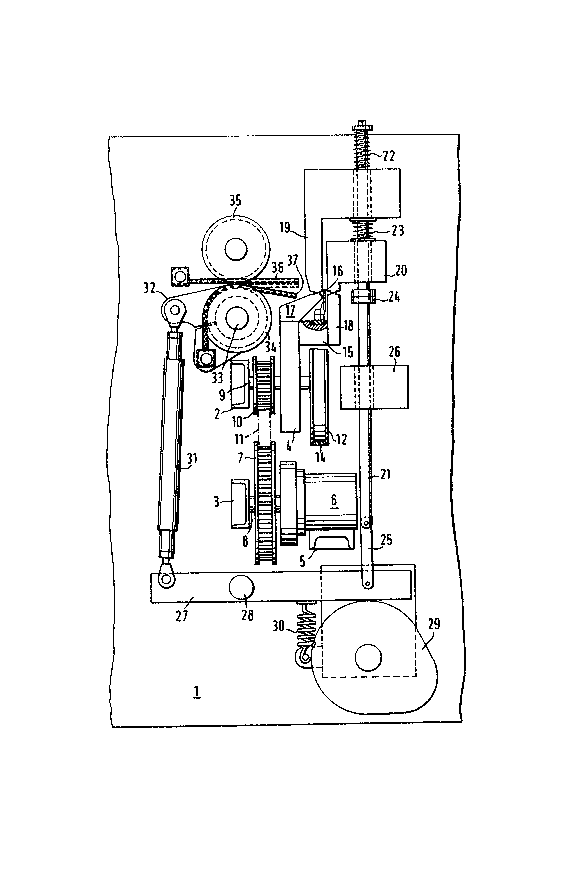Une partie des informations de ce site Web a été fournie par des sources externes. Le gouvernement du Canada n'assume aucune responsabilité concernant la précision, l'actualité ou la fiabilité des informations fournies par les sources externes. Les utilisateurs qui désirent employer cette information devraient consulter directement la source des informations. Le contenu fourni par les sources externes n'est pas assujetti aux exigences sur les langues officielles, la protection des renseignements personnels et l'accessibilité.
L'apparition de différences dans le texte et l'image des Revendications et de l'Abrégé dépend du moment auquel le document est publié. Les textes des Revendications et de l'Abrégé sont affichés :
| (12) Brevet: | (11) CA 1264421 |
|---|---|
| (21) Numéro de la demande: | 1264421 |
| (54) Titre français: | APPAREIL POUR LA FABRICATION DE SACS |
| (54) Titre anglais: | APPARATUS FOR MAKING BAGS |
| Statut: | Périmé et au-delà du délai pour l’annulation |
| (51) Classification internationale des brevets (CIB): |
|
|---|---|
| (72) Inventeurs : |
|
| (73) Titulaires : |
|
| (71) Demandeurs : |
|
| (74) Agent: | MARKS & CLERK |
| (74) Co-agent: | |
| (45) Délivré: | 1990-01-16 |
| (22) Date de dépôt: | 1986-09-02 |
| Licence disponible: | S.O. |
| Cédé au domaine public: | S.O. |
| (25) Langue des documents déposés: | Anglais |
| Traité de coopération en matière de brevets (PCT): | Non |
|---|
| (30) Données de priorité de la demande: | ||||||
|---|---|---|---|---|---|---|
|
ABSTRACT
Apparatus for making bags from a two-ply web of
thermoplastic material comprises feed rollers for
intermittently pushing forward the web in steps
corresponding to a bag length into a gap between welding
beams, which comprise an upper welding beam provided with
drive means for lifting and lowering said upper welding
beam. The apparatus also comprises a severing knife,
which extends below the web and parallel to the lower
welding beam beside the same and is secured to a endless
tensile element, which revolves around pulleys. The upper
welding beam is adapted to force down the web into the
cutting range of the severing knife. The feed rollers
directly precede the welding beams and are disposed in
rows of upper and lower guide rods or air-blowing tubes,
which rods or tubes are arranged like combs and cause the
web to move between said rows in a plane disposed above
the path of the knife as the web enters the gap between
the opened welding beams. The lower welding beam is
fixedly mounted on the frame. The continually revolving
knife moves through that plane for the web which is
defined by the lower welding beam as the transverse seam
weld is made. Means are provided which are actuated as the
upper welding beam is lowered and serve to impart a
pivotal movament to the lower row of guide rods or
air-blowing tubes toward the lower welding beam.
Note : Les revendications sont présentées dans la langue officielle dans laquelle elles ont été soumises.
Note : Les descriptions sont présentées dans la langue officielle dans laquelle elles ont été soumises.

2024-08-01 : Dans le cadre de la transition vers les Brevets de nouvelle génération (BNG), la base de données sur les brevets canadiens (BDBC) contient désormais un Historique d'événement plus détaillé, qui reproduit le Journal des événements de notre nouvelle solution interne.
Veuillez noter que les événements débutant par « Inactive : » se réfèrent à des événements qui ne sont plus utilisés dans notre nouvelle solution interne.
Pour une meilleure compréhension de l'état de la demande ou brevet qui figure sur cette page, la rubrique Mise en garde , et les descriptions de Brevet , Historique d'événement , Taxes périodiques et Historique des paiements devraient être consultées.
| Description | Date |
|---|---|
| Inactive : CIB désactivée | 2021-10-09 |
| Inactive : CIB désactivée | 2021-10-09 |
| Inactive : CIB désactivée | 2021-10-09 |
| Inactive : CIB désactivée | 2021-10-09 |
| Inactive : CIB en 1re position | 2019-07-23 |
| Inactive : CIB attribuée | 2019-07-23 |
| Inactive : CIB attribuée | 2019-07-23 |
| Inactive : CIB attribuée | 2019-07-23 |
| Inactive : CIB expirée | 2017-01-01 |
| Inactive : CIB expirée | 2017-01-01 |
| Inactive : CIB expirée | 2017-01-01 |
| Inactive : CIB expirée | 2017-01-01 |
| Inactive : CIB de MCD | 2006-03-11 |
| Inactive : CIB de MCD | 2006-03-11 |
| Inactive : Demande ad hoc documentée | 1993-01-16 |
| Le délai pour l'annulation est expiré | 1992-07-18 |
| Lettre envoyée | 1992-01-16 |
| Accordé par délivrance | 1990-01-16 |
Il n'y a pas d'historique d'abandonnement
Les titulaires actuels et antérieures au dossier sont affichés en ordre alphabétique.
| Titulaires actuels au dossier |
|---|
| WINDMOLLER & HOLSCHER |
| Titulaires antérieures au dossier |
|---|
| FRITZ ACHELPOHL |
| HELMUT SIMON |